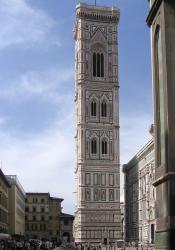Giotto's Campanile
Constructed between 1302 and 1359, Giotto’s Campanile is one of the best examples of the Florentine Gothic style of Architecture in the city. The bell tower is overlaid with red, green and white marble similar to the other structures in the Piazza del Duomo and is characterized by its many geometric panels and carved lozenges. Additionally, the top levels of the bell tower were designed to increase in size at higher levels, using forced perspective to make each level appear the same size.
The sculptural artwork on the exterior of the Campanile is particularly of interest as well because, as each new level of the tower was constructed, the clear shift in artistic stylings from a variety of periods is shown. The lowest level uses bas (low) relief to depict the creation of man. The next set are created on blue backgrounds in what is considered a nod to the backgrounds often used in Giotto’s paintings and show themes such as “The cardinal virtues” and “The Liberal Arts”. Above that are several levels of statues ranging from the stylized Byzantine forms of Andrea Pissano to the realistic and individualized renaissance sculptures of Donatello. The Bell tower demonstrates the clear shift in Medieval to Renaissance not only through the progression of art styles, but also through the themes these works depict, which is laudatory of human creativity and creation.
Trachtenberg, Marvin. The Campanile of Florence Cathedral: "Giotto's Tower.". New York, New York University Press, 1971.
“Giotto's Bell Tower.” Il Grande Museo Del Duomo, www.museumflorence.com/monuments/4-bell-tower.
Image: By Julie Anne Workman (Own work) [CC BY-SA 3.0 (https://creativecommons.org/licenses/by-sa/3.0)], via Wikimedia Commons https://commons.wikimedia.org/wiki/File%3AGiotto's_campanile-263.jpg

